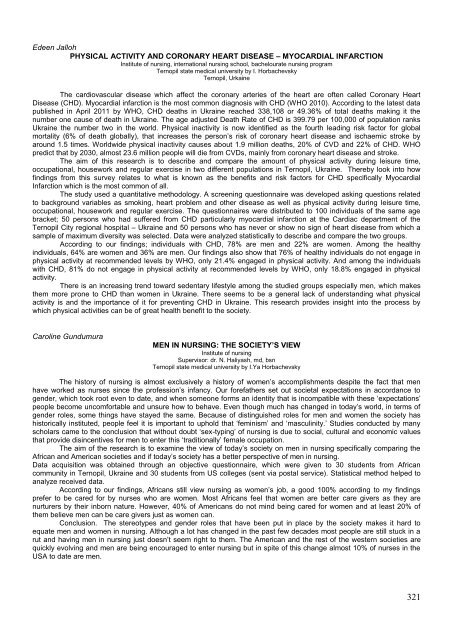ÐбÑÑник Ñез XVI ÐÑжнаÑодно медиÑного конгÑеÑÑ ÑÑÑденÑÑв Ñа ...
ÐбÑÑник Ñез XVI ÐÑжнаÑодно медиÑного конгÑеÑÑ ÑÑÑденÑÑв Ñа ...
ÐбÑÑник Ñез XVI ÐÑжнаÑодно медиÑного конгÑеÑÑ ÑÑÑденÑÑв Ñа ...
You also want an ePaper? Increase the reach of your titles
YUMPU automatically turns print PDFs into web optimized ePapers that Google loves.
Edeen Jalloh<br />
PHYSICAL ACTIVITY AND CORONARY HEART DISEASE – MYOCARDIAL INFARCTION<br />
Institute of nursing, international nursing school, bachelourate nursing program<br />
Ternopil state medical university by I. Horbachevsky<br />
Ternopil, Urkaine<br />
The cardiovascular disease which affect the coronary arteries of the heart are often called Coronary Heart<br />
Disease (CHD). Myocardial infarction is the most common diagnosis with CHD (WHO 2010). According to the latest data<br />
published in April 2011 by WHO, CHD deaths in Ukraine reached 338,108 or 49.36% of total deaths making it the<br />
number one cause of death in Ukraine. The age adjusted Death Rate of CHD is 399.79 per 100,000 of population ranks<br />
Ukraine the number two in the world. Physical inactivity is now identified as the fourth leading risk factor for global<br />
mortality (6% of death globally), that increases the person‘s risk of coronary heart disease and ischaemic stroke by<br />
around 1.5 times. Worldwide physical inactivity causes about 1.9 million deaths, 20% of CVD and 22% of CHD. WHO<br />
predict that by 2030, almost 23.6 million people will die from CVDs, mainly from coronary heart disease and stroke.<br />
The aim of this research is to describe and compare the amount of physical activity during leisure time,<br />
occupational, housework and regular exercise in two different populations in Ternopil, Ukraine. Thereby look into how<br />
findings from this survey relates to what is known as the benefits and risk factors for CHD specifically Myocardial<br />
Infarction which is the most common of all.<br />
The study used a quantitative methodology. A screening questionnaire was developed asking questions related<br />
to background variables as smoking, heart problem and other disease as well as physical activity during leisure time,<br />
occupational, housework and regular exercise. The questionnaires were distributed to 100 individuals of the same age<br />
bracket; 50 persons who had suffered from CHD particularly myocardial infarction at the Cardiac department of the<br />
Ternopil City regional hospital – Ukraine and 50 persons who has never or show no sign of heart disease from which a<br />
sample of maximum diversity was selected. Data were analyzed statistically to describe and compare the two groups.<br />
According to our findings; individuals with CHD, 78% are men and 22% are women. Among the healthy<br />
individuals, 64% are women and 36% are men. Our findings also show that 76% of healthy individuals do not engage in<br />
physical activity at recommended levels by WHO, only 21.4% engaged in physical activity. And among the individuals<br />
with CHD, 81% do not engage in physical activity at recommended levels by WHO, only 18.8% engaged in physical<br />
activity.<br />
There is an increasing trend toward sedentary lifestyle among the studied groups especially men, which makes<br />
them more prone to CHD than women in Ukraine. There seems to be a general lack of understanding what physical<br />
activity is and the importance of it for preventing CHD in Ukraine. This research provides insight into the process by<br />
which physical activities can be of great health benefit to the society.<br />
Caroline Gundumura<br />
MEN IN NURSING: THE SOCIETY’S VIEW<br />
Institute of nursing<br />
Supervisor: dr. N. Haliyash, md, bsn<br />
Ternopil state medical university by I.Ya Horbachevsky<br />
The history of nursing is almost exclusively a history of women‘s accomplishments despite the fact that men<br />
have worked as nurses since the profession‘s infancy. Our forefathers set out societal expectations in accordance to<br />
gender, which took root even to date, and when someone forms an identity that is incompatible with these ‗expectations‘<br />
people become uncomfortable and unsure how to behave. Even though much has changed in today‘s world, in terms of<br />
gender roles, some things have stayed the same. Because of distinguished roles for men and women the society has<br />
historically instituted, people feel it is important to uphold that ‗feminism‘ and ‗masculinity.‘ Studies conducted by many<br />
scholars came to the conclusion that without doubt ‗sex-typing‘ of nursing is due to social, cultural and economic values<br />
that provide disincentives for men to enter this ‗traditionally‘ female occupation.<br />
The aim of the research is to examine the view of today‘s society on men in nursing specifically comparing the<br />
African and American societies and if today‘s society has a better perspective of men in nursing.<br />
Data acquisition was obtained through an objective questionnaire, which were given to 30 students from African<br />
community in Ternopil, Ukraine and 30 students from US colleges (sent via postal service). Statistical method helped to<br />
analyze received data.<br />
According to our findings, Africans still view nursing as women‘s job, a good 100% according to my findings<br />
prefer to be cared for by nurses who are women. Most Africans feel that women are better care givers as they are<br />
nurturers by their inborn nature. However, 40% of Americans do not mind being cared for women and at least 20% of<br />
them believe men can be care givers just as women can.<br />
Conclusion. The stereotypes and gender roles that have been put in place by the society makes it hard to<br />
equate men and women in nursing. Although a lot has changed in the past few decades most people are still stuck in a<br />
rut and having men in nursing just doesn‘t seem right to them. The American and the rest of the western societies are<br />
quickly evolving and men are being encouraged to enter nursing but in spite of this change almost 10% of nurses in the<br />
USA to date are men.<br />
321
















